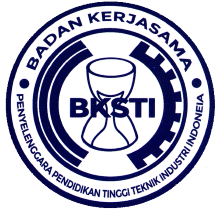Ekstraksi Minyak Gaharu dengan Pelarut Etanol secara Maserasi
DOI:
https://doi.org/10.52759/reactor.v2i2.39Keywords:
Agarwood, Essential Oil, Maceration time, Particle Size, YieldAbstract
Agarwood is one of the forest products that can be utilized and has a high selling value. Agarwood contains essential oils which have many active compounds and contains a specific aromatic resin that is naturally formed as a form of defense against physical damage or microbial infection. Agarwood essential oil with good quality has a high economic value. This study aims to extract agarwood essential oil using ethanol as a solvent. The optimal yield of agarwood essential oil can be obtained by varying the particle size, the ratio of the weight of the agarwood biomass (kg) to the volume of the solvent (L), and the length of maceration (h). The results showed that the particle size of agarwood did notaffect the yield of agarwood essential oil. The results of the comparison of agarwood biomass with the volume of the solvent showed that the ratio of 1:9 (w/v) obtained the highest yield of 4.02% and the longest maceration time with the highest yield of 4.12% for 72 hours. However, 48 hours of maceration had a greater increase in yield compared to 72 hours of maceration. The increase in yield at 48 hours to 72 hours of maceration was only 0.22% when compared to the increase in yield at 24 hours to 48 hours of maceration, which was 0.56%.
References
A. Marfina, E. Cahyono, S. Mursiti, and Harjono, “Indonesian Journal of Chemical Science Sintesis Nanopartikel Emas dengan Bioreduktor Minyak Atsiri Kayu Manis (Cinnamomum burmannii),” Indo. J. Chem. Sci, vol. 8, no. 2, pp. 2–8, 2019.
M. M. Al Hanief, H. A. M. W, and I. Pendahuluan, “Ekstraksi Minyak Atsiri dari Akar Wangi Menggunakan Metode Steam - Hydro distillation dan Hydro distilation dengan Pemanas Microwave,” vol. 2, no. 2, 2013.
A. Aqmarina Nasution, U. J. Siregar, Miftahudin, and M. Turjaman, “Identification of chemical compounds in agarwood-producing species Aquilaria malaccensis and Gyrinops versteegii,” J. For. Res., vol. 31, no. 4, pp. 1371–1380, 2020, doi: 10.1007/s11676-018-00875-9.
A. Putra, A. D. Prastiawan, and D. Prihanto, “Menggali potensi dan masalah pengembangan gaharu (Aquilaria spp) di Desa Putat Lor,” J. Karinov, vol. 3, no. 2, pp. 121–125, 2020.
H. S. Kusuma, A. Altway, and M. Mahfud, “Solvent-free microwave extraction of essential oil from dried patchouli (Pogostemon cablin Benth) leaves,” J. Ind. Eng. Chem., vol. 58, pp. 343–348, 2018, doi: 10.1016/j.jiec.2017.09.047.
A. F. A. Rahim, A. Kadri, and N. M. Harun, “The effect of enzymatic pre-treatment in agarwood oil extraction,” Int. J. Adv. Sci. Eng. Inf. Technol., vol. 9, no. 4, pp. 1317–1323, 2019, doi: 10.18517/ijaseit.9.4.3892.
Y. Z. H. Y. Hashim, P. G. Kerr, P. Abbas, and H. Mohd Salleh, “Aquilaria spp. (agarwood) as source of health beneficial compounds: A review of traditional use, phytochemistry and pharmacology,” J. Ethnopharmacol., vol. 189, pp. 331–360, 2016, doi: 10.1016/j.jep.2016.06.055.
Herliani, “Analisis Volume Minyak Gaharu Tipe Aquilaria malaccensis L. pada Proses Penyulingan Minyak Gaharu,” Procceding Biol. Educ. Conf., vol. 15, no. 1, pp. 743–749, 2018.
F. A. Abdul Kadir, K. A. Azizan, and R. Othman, “Datasets of essential oils from naturally formed and synthetically induced Aquilaria malaccensis agarwoods,” Data Br., vol. 28, p. 104987, 2020, doi: 10.1016/j.dib.2019.104987.
N. Sulaiman et al., “Effects of extraction methods on yield and chemical compounds of gaharu (Aquilaria malaccensis),” J. Trop. For. Sci., vol. 27, no. 4, pp. 413–419, 2015.
I. Triesty and M. Mahfud, “Ekstraksi Minyak Atsiri dari Gaharu (Aquilaria Malaccensis) dengan Menggunakan Metode Microwave Hydrodistillation dan Soxhlet Extraction,” J. Tek. ITS, vol. 6, no. 2, 2017, doi: 10.12962/j23373539.v6i2.24491.
N. Atikah, M. Yusoff, S. N. Tajuddin, A. Hisyam, N. Adila, and M. Omar, “Agarwood Essential Oil: Study on Optimum Parameter and Chemical Compounds of Hydrodistillation Extraction,” J. Appl. Sci. Agric. J. Appl. Sci. Agric, vol. 10, no. 105, pp. 1–5, 2015, [Online]. Available: www.aensiweb.com/JASA.
S. Ngadiran et al., “Effect of solvent types on gaharu (Aqualaria malaccensis) extract quality and its chemical compound,” Key Eng. Mater., vol. 797, pp. 202–210, 2019, doi: 10.4028/www.scientific.net/KEM.797.202.
B. Rahmanto et al., “Characterization of Ethanol Extract from Agarwood (Aquilaria microcarpa Baill.) Leaf,” J. Jamu Indones., vol. 3, no. 2, pp. 68–74, 2018, doi: 10.29244/jji.v3i2.56.
G. Pasaribu, T. K. Waluyo, and G. Pari, “Analisis Komponen Kimia Beberapa Kualitas Gaharu Dengan Kromatografi Gas Spektrometri Massa,” J. Penelit. Has. Hutan, vol. 31, no. 3, pp. 181–185, 2013, doi: 10.20886/jphh.2013.31.3.181-185.
Rondang Tambun, Harry P. Limbong, Christika Pinem, and Ester Manurung, “Pengaruh Ukuran Partikel, Waktu Dan Suhu Pada Ekstraksi Fenol Dari Lengkuas Merah,” J. Tek. Kim. USU, vol. 5, no. 4, pp. 53–56, 2017, doi: 10.32734/jtk.v5i4.1555.
N. C. Radzi and F. A. Kasim, “Effect of microwave pretreatment on gaharu essential oil using hydrodistillation method,” Indones. J. Chem., vol. 20, no. 4, pp. 960–966, 2020, doi: 10.22146/ijc.43191.
N. Sulaiman et al., “Enhancement of gaharu oleoresin quality by process optimization using response surface methodology,” Biocatal. Agric. Biotechnol., 2019.
M. Samadi, Z. Z. Abidin, R. Yunus, D. R. Awang Biak, H. Yoshida, and E. H. Lok, “Assessing the kinetic model of hydro-distillation and chemical composition of Aquilaria malaccensis leaves essential oil,” Chinese J. Chem. Eng., vol. 25, no. 2, pp. 216–222, 2017, doi: 10.1016/j.cjche.2016.09.006.
Y. Nyamien et al., “Effect of Solvents and Solid- Liquid Ratio on Caffeine Extraction from Côte d ’ Ivoire Kola Nuts ( Cola nitida ),” Int. J. Sci. Res., vol. 4, no. 1, pp. 218–222, 2013.
I. Kurniawati, Maftuch, and A. M. Hariati, “Penentuan Pelarut Dan Lama Ekstraksi Terbaik Pada Teknik Maserasi Gracilaria sp. Serta Pengaruhnya Terhadap Kadar Air Dan Rendemen,” Samakia J. Ilmu Perikan., vol. 7, no. 2, pp. 72–77, 2016, [Online]. Available: http://www.samakia.aperiki.ac.id/index.php/JSAPI /article/view/106.




